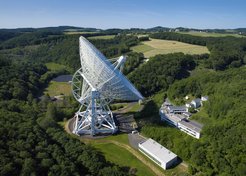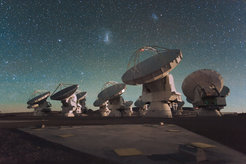World Radiocommunication Conference puts radio astronomy on the agenda
New studies to improve the protection of radio astronomy measurements from satellite systems
Thousands of delegates from member states of the International Telecommunication Un-ion and representatives from industry and science met for four weeks in Dubai. The World Radiocommunication Conference set the course for new applications for radio communication. The focus was also on protecting radio astronomy, in particular from the effects of new satellite constellations. Radio astronomers, including those from the Max Planck Institute for Radio Astronomy in Bonn, Germany, have been active in spectrum management for many years. They are calling for the International Telecommunication Union to update its rules and processes in order to keep pace with the changing situation. Studies are now to be carried out before the next world radio conference in 2027. The aim is to identify improved technical or regulatory measures so that the exploration of the secrets of the universe can be continued in the future.

Fig. 1: The radio telescope in Effelsberg is one of the most important astronomical observatories in the world. Its location in a picturesque Eifel valley has provided good protection from man-made radio transmissions for decades. However, the increased use of broadband communication via large satellite constellations is causing more and more headaches for astronomers, as satellites are high in the sky all over the world.
"Considering that radio astronomy is a pivotal scientific discipline that plays a crucial role in unraveling the mysteries of the cosmos" - these are the opening words of a new resolution of the International Telecommunication Union (ITU), which was adopted last Friday at the World Radiocommunication Conference in Dubai. "This finally acknowledges a problem that radio astronomy has faced due to the extreme increase in the number of satellites in near-Earth space," says Benjamin Winkel from the Max Planck Institute for Radio Astronomy (MPIfR). He and his colleagues have been working for years to ensure that the rules and processes at the International Telecommunication Union are updated to keep pace with the changed situation.
World Radiocommunication Conferences take place every 3 to 4 years. Thousands of delegates from countries, in particular the telecommunications authorities (in Germany: Bundesnet-zagentur), as well as other interest groups from industry, business and science meet for 4 weeks to work on the so-called radio regulations. This is an international set of agreements designed to regulate the smooth interaction of all radio services. If, for example, new mobile radio frequencies are to be made usable, dozens of technical studies have to be carried out beforehand to ensure that existing applications are not disrupted. The frequencies that are "made available" by nature - the radio spectrum - are already in full use. Certain frequency ranges have also been reserved for radio astronomy in order to protect particularly important observation frequencies. "However, these frequencies are far too few for modern radio astronomy," reports Gyula Józsa, also from the MPIfR."The problem of human-made interference which can impact the sensitive radio astronomical receivers was already known over 50 years ago. This was actually the reason why the 100-m radio telescope, which is operated by the MPIfR, was built in a valley in the Eifel and not in the middle of the city of Bonn. It's location ensures a certain degree of natural shielding." Of course, the new satellite systems, such as SpaceX/Starlink, OneWeb or Amazon/Kuiper, cannot be avoided in this way. After all, the aim of these companies is to provide Internet access everywhere on Earth.
From a European perspective, this applies in particular to the two international flagship projects, ALMA (with telescopes in Chile) and SKAO (with telescopes in South Africa & Australia). Astronomical institutes and organizations worldwide are investing billions in these ob-servatories. For South Africa and Chile, however, these ventures also play a strategic role in the nations’ development. They are infrastructure measures, educational institutions and places of international cooperation all in one. Busang Sethole from the South African Radio Astronomy Observatory (SARAO) is determined that these projects, of all things, should not be jeopardized. "Reflecting on our collective efforts, I recognize room for improvement. Developing nations only started participating in the ITU after the GE06 conference, which stands in stark contrast to the institutional knowledge amassed by developed countries over 156 years. This wealth of experience should ideally facilitate, not inhibit, the needs of developing nations," said Sethole during the conference.
The fact that the needs of astronomers were addressed at all at the World Radiocommunication Conference was only possible because two important regional organizations had declared the topic a top priority in the run-up to the conference. One was the European Conference of Postal and Telecommunication Administrations (CEPT), which wanted to see the already existing protection criteria for radio astronomy better enforced. The second was the African Telecommunications Union (ATU), which has brought the issue of special radio quiet zones to the international stage. These zones are areas in which terrestrial radio equipment is restricted in the vicinity of observatories in order to create better observation conditions. However, these are purely national regulatory interventions and cannot influence satellite systems, which are subject to international rules.
The World Radiocommunication Conference in Dubai decided to combine both proposals and called on the member states to develop possible technical and regulatory solutions by the next conference in 2027. "This is still a lot of work for the radio astronomers involved," says Gyula Józsa, who led the working group on this topic in Dubai. Benjamin Winkel adds: "Nevertheless, we are very confident, because we have already done a lot of the necessary preparatory work with our European spectrum management organization, CRAF, and our colleagues from SKAO."

Further Information
The Committee on Radio Astronomy Frequencies (CRAF) of the European Science Foun-dation coordinates activities to keep the frequency bands used by radio astronomy and space sciences free from interference on behalf of European radio astronomers. The science of radio astronomy plays a key role in increasing our understanding of the environment and the uni-verse in which we live. By its nature it is a passive service, so it never causes interference to other users of radio, but unfortunately it is becoming increasingly difficult to protect radio astronomy operations from radio interference as use of the spectrum increases for both terres-trial and space-borne communications.
The Square Kilometre Array Observatory (SKAO) will operate radio telescopes at two sites in South Africa and Australia. It is based on a successful international collaboration combining brilliant know-how from 16 countries including Germany with the goal of outstanding science that achieves new breakthroughs in research. In addition to science, society benefits. Astronomy is a major driver of new technological solutions - especially in engineering, optics, precision engineering and computer science. As a result, astronomy is also setting new directions in the education of STEM professionals. With sites in South Africa and Australia and the headquarters in the United Kingdom, the SKAO so far also includes China, Italy, the Netherlands, Portugal, Spain and Switzerland as full members as well as France, Germany, India, Japan, Canada, South Korea and Sweden as observers.ited Kingdom, the SKAO so far also includes China, Italy, the Netherlands, Portugal and Switzerland as members. Observers are France, India, Japan, Canada, Spain, South Korea and Sweden.
The Atacama Large Millimeter/submillimeter Array (ALMA), an international astronomy facility, is a partnership of the European Southern Observatory (ESO), the U.S. National Sci-ence Foundation (NSF) and the National Institutes of Natural Sciences (NINS) of Japan in cooperation with the Republic of Chile. ALMA is funded by ESO on behalf of its Member States, by NSF in cooperation with the National Research Council of Canada (NRC) and the Ministry of Science and Technology (MOST) and by NINS in cooperation with the Academia Sinica (AS) in Taiwan and the Korea Astronomy and Space Science Institute (KASI). ALMA construction and operations are led by ESO on behalf of its Member States; by the National Radio Astronomy Observatory (NRAO), managed by Associated Universities, Inc. (AUI), on behalf of North America; and by the National Astronomical Observatory of Japan (NAOJ) on behalf of East Asia. The Joint ALMA Observatory (JAO) provides the unified leadership and management of the construction, commissioning and operation of ALMA.

